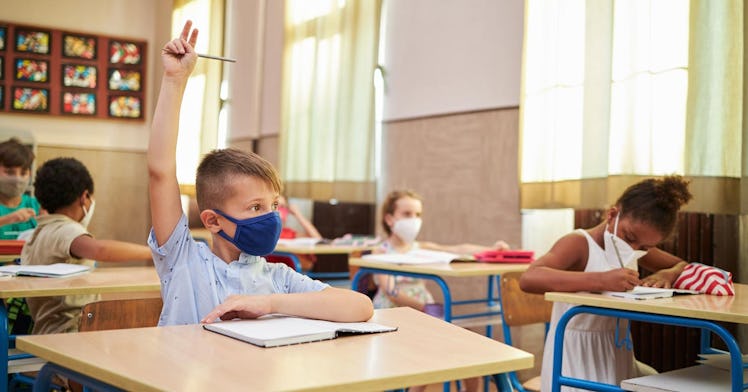CDC Cuts School Social Distancing Recommendation in Half
The move has wide-ranging implications. Here's what parents need to know.

A little over a month after the Centers for Disease Control published updated guidance on school reopening, the first such guidance of the Biden administration, the agency is implementing a fairly radical change to those very same recommendations.
Instead of the six feet minimum for social distancing that’s been drilled into our heads since pretty much the start of the pandemic, the agency is instituting a three-foot recommendation between students attending elementary school. It’s recommending the same for kids in middle and high school as long as community transmission is low.
All of these recommendations are still contingent on every student and teacher faithfully following other precautions like universal masking, contract tracing, hand washing, and, when a positive test pops up at a school, contact tracing, isolation, and quarantine. Good airflow within school buildings is also a must.
Behind the now-official change in policy are considerations both practical and scientific.
Why the Change?
Requiring schools to keep six feet of distance between desks means that it’s pretty much impossible for them to open at full capacity, given the reality for many high schools in the United States, with small classrooms and too many students to fill them.
Imagine a classroom in your high school. Now imagine having to keep the desks six feet apart from each other. Not as many desks can fit in the room, right?
Standard classrooms can hold a small number of students six feet apart or a standard class size much closer together. They can’t do both, which presents a big problem to school districts that are trying to reopen in-person learning to all students.
Is “Three Feet” Enough?
The short answer: maybe.
A study published on March 10 in Clinical Infectious Diseases included 251 eligible school districts in Massachusetts, 537,336 students and 99,390 staff attending in-person instruction during the 16-week study period. Student and staff case rates were similar across districts regardless of whether they had ≥3 feet and ≥6 feet distancing policies.
The study concluded that “lower physical distancing policies can be adopted in school settings with masking mandates without negatively impacting student or staff safety.”
Still, the authors also noted that it’s possible that the districts that allowed for three feet of distancing could actually provide more (hence the ≥ throughout) and that this potential gap between policy and implementation is a weakness of their study design.
The World Health Organization already suggests that one meter (3.28 feet) of distance is safe for schools while the American Academy of Pediatrics says “desks should be placed at least 3 feet apart and ideally 6 feet apart.” The CDC’s new guidance puts it more in line with these organizations.
Dr. Rochelle Walensky, the director of the CDC, said that her agency “is committed to leading with science and updating our guidance as new evidence emerges. These updated recommendations provide the evidence-based road map to help schools reopen safely, and remain open for in-person instruction.”
Notably, the three feet rule only applies to students in classrooms. The CDC still recommends six feet of distance for aduts and students in common areas, any time students are eating and drinking (and therefore maskless), and doing exhalation-intense activities like chorus, band, and sports practice, which “should be moved outdoors or to large well-ventilated spaces whenever possible.”